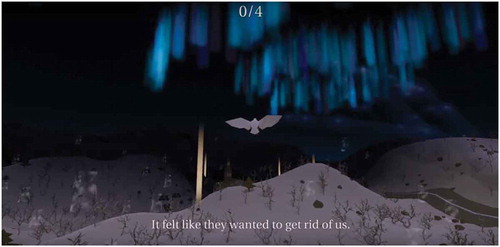The important function games have held in Sámi culture over time. Sámi games reflected priorities and expressions in relating to the land, as seen in the prominence of animal and nature themes . When used as a pedagogic tool, games allowed children to imitate working adults via playful practices, enacting roleplay around Sámi traditional livelihoods. Hence, Sámi play and games have also been a platform to pass on traditional knowledge.
Overall, games have been significant in sustaining livelihood, traditional Sámi pedagogy, as much as in politics of Sámi erasure and colonisation . The employment of digital technology in Indigenous settings is nothing new. Global efforts around Indigenous technology include Aboriginal digital databases, and Virtual Reality art projects . More specifically regarding game development, there are increasing efforts to integrate game development tools and Indigenous storytelling.
Furthermore, there was a continuation of ancient Sámi game elements, using nature and animal motifs. Most of the games, including the three examples discussed, used input devices engaging the whole human body in play to experience their game characters and thus engage with concerns of a contemporary Sámi community using high-end gaming hardware. Overall, these elements of the game jam resonate with educational principles of Sámi intangible heritage, focusing on embodied, holistic ways of learning. Rather than framing Sámi intangible heritage as incompatible with digital expressions, maintaining tired dichotomies of old versus new, traditional versus modern, or analogue versus digital, Sámi Game Jam created a ‘digital campfire’ , connecting the jammers around living expressions of Sáminess. This suggests that digital games can be a potent tool for cultural revitalisation, as they allow jammers to express current concerns from the inside, as dynamic rules, mechanics, control schemes, and audio-visual elements.
Noticeably, game jamming is a contemporary cultural technique suitable for different age groups. For young Sámi audiences, the games present an engaging platform to explore familiar stories and environments through immersive gadgets and state-of-the-art technology. On a symbolic level, this presents their culture as something ‘cool’ and contemporary; something one wants to experience with friends, to celebrate, enjoy, and invest in, rather than something to be ashamed of, as was previously the case.
There also are examples for intersections between Indigenous game creation and the gaming market. Perhaps most famously, Never Alone is a game involving the Cook Inlet Tribal Council (2017) featuring the Iñupiaq language through Alaskan Native storytellers’ voices. In an attempt to present traditional Indigenous storytelling in a contemporary medium, Never Alone’s storyline is based on the Kunuuksaayuka story, a piece of intangible heritage. Never Alone’s creative process begs the question of Indigenous agency. While inspired by Cook Inlet Tribal Council ideas, the development team had only one Indigenous member. Furthermore, as a commercial game, Never Alone was partly driven by the need to generate revenues, compromising ways to represent Indigenous heritage. This questions how much of the game was an attempt to appeal to Western player audiences, rendering well-meaning attempts at Indigenous representation mere ornamentation. Overall, this may lead to dynamics where the game performs preservation at the cost of repeating colonial structures: Western mechanics decorated by ‘authentic’ Indigenous ornamentation. Acutely aware of a reality in which Indigenous languages and practices erode, Indigenous communities are caught in a situation of ethnostress: There is urgency in preserving cultural elements, but doing so by the rules of an industry may further erase their voices through cultural appropriation and self-censorship. Indigenous game makers may choose to go with harmful conventions out of fear of losing their cultural heritage altogether. Overall, the Indigenous pressure for rapid solutions against cultural losses potentially leads to both positive and negative results.
Analysis:
This research shows that video games could be efficient media to help indigenous people find confidence in their own culture. However, we should be aware that, when the video game interacts with the capital, indigenous people may lose ownership of their own culture. Especially when getting profit is the first goal, the culture of the indigenous people might be undermined.




